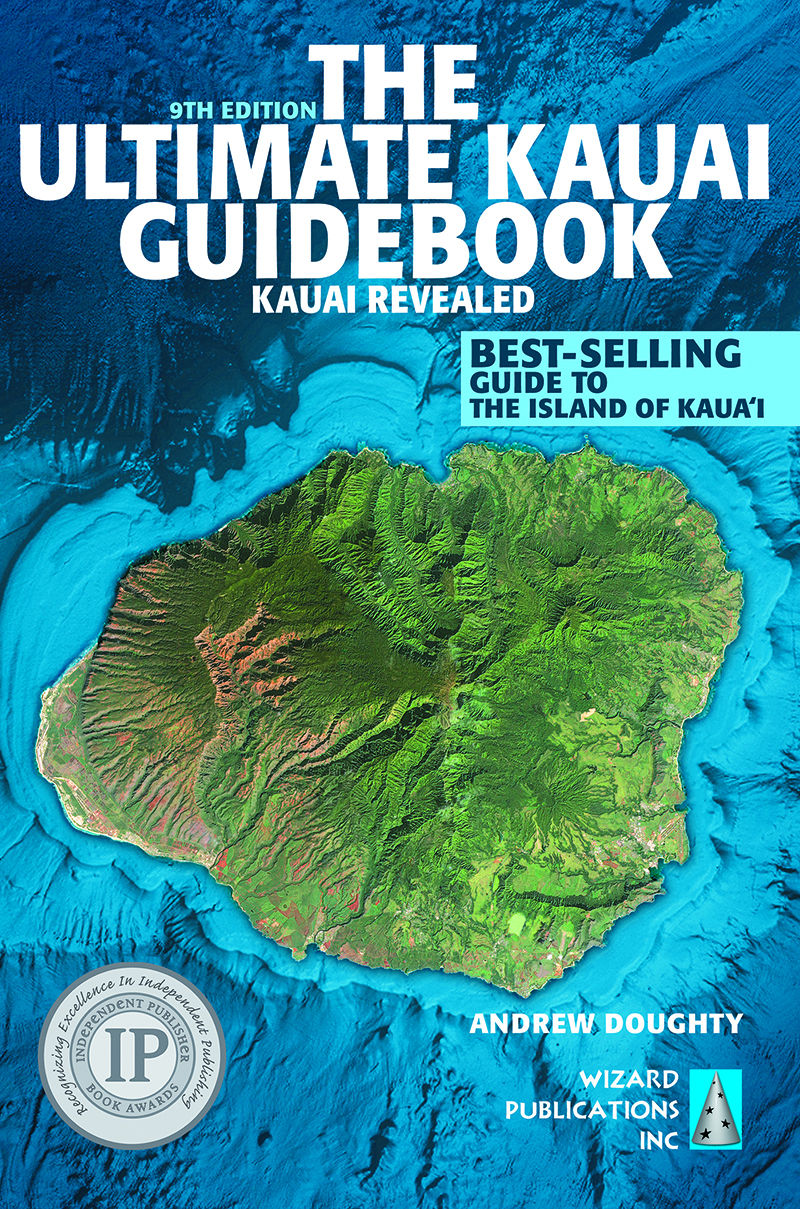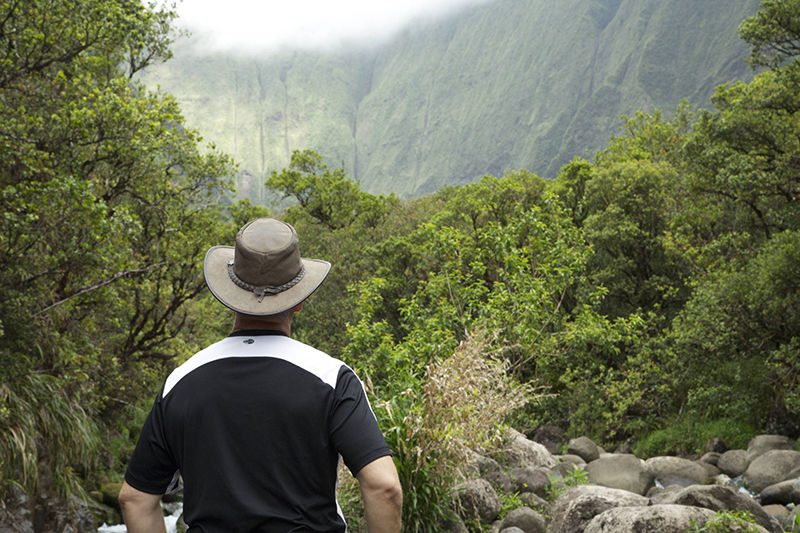Revealing more about ‘Hawaii Revealed’
KAPAA — Andrew Doughty, author of the top-selling “Hawaii Revealed” series of guidebooks, likes to keep a low profile. That’s because for more than two decades, he has anonymously visited nearly every restaurant, hotel, tourist activity, beach and hiking trail in the state in order to review them as honestly and impartially as possible.
“Ninety-nine percent of the time I’m able to fly under the radar, but once in a while I’ll get busted,” Doughty said. “The problem with getting busted is they will treat me better than anyone else.”
Doughty, of Kapaa, rarely talks to media, but in an interview with The Garden Island he shared how he wrote a wildly popular series of guidebooks now sold in stores across the world. He also talked about the controversy caused by revealing places many residents would like to keep secret.
The story began more than two decades ago, when Doughty was first living on Kauai and working as unskilled labor in the construction industry. He spent his free time exploring the island, but got frustrated when weekend after weekend he was unable to find Waiakalua Beach.
“I looked at a couple of guidebooks, but they all referred to a road that hadn’t existed in a long time,” he explained.
Doughty thought he could do better, and decided to write his own guidebook. There were only a few problems with the plan: He didn’t have any money, he could barely use a computer, he didn’t have any connections in the publishing industry, and he had absolutely no idea how to write a book.
Doughty tried to get a loan from a local bank, but “They laughed me out of the office. And with good reason.” So he applied for every credit card he could, bought a computer, bought a word processing program, and bought a book on how to write.
For the next year, Doughty spent his mornings checking out various tourist activities like helicopter rides and snorkel tours. Then he would review a restaurant at lunch (all of which he paid for by charging everything to his credit card, at 22 percent interest). Then he would spend more time exploring the island in the afternoon before eventually returning to his 290-square-foot home in Wailua to have a simple dinner of chicken and rice, “because it was so cheap.”
Finding tourist attractions and restaurants to review was easy because of all the free fliers and advertisements scattered across the island. But finding hiking trails and natural features was harder. People rarely told him where to find things; almost everything he found, he discovered on his own.
“I had a rule. I would never read what anyone else said about the island,” Doughty said. It’s a rule the author still follows today.
One of the first things Doughty did when starting this project was to get all of the topographical maps he could from the government and put them on a giant wall, so he could study them for an hour first thing in the morning. This was before the invention of Google Earth, after all. He also had a map from the county that showed all the legal public access routes. Then he would go out and explore to see what he could find.
“After awhile, you get an instinct for where things were,” Doughty said. “When that’s all you do, you develop the skills for it. I can smell it when a waterfall is nearby.”
Doughty chose to start with Kauai primarily because he thought it would be the least challenging, but also because he thought the island was underappreciated by other publishers. Back then, Doughty’s competitors mostly focused on the entire state.
“Kauai Revealed” came out in March 1994. Doughty paid to print 10,000 copies of the book himself. But distribution was a problem: “On the Mainland, they didn’t know what Kauai was — they thought it was in the Caribbean somewhere.”
So Doughty mailed free copies of his book to newspapers across the county to review (this was in the pre-Internet days) and if they reviewed it, he would send a copy of the article to a distributor. His first order was for only one case, but the books quickly proved popular with travelers because of his engaging writing style, thorough reviews and extensive knowledge of the island. After a year, Borders agreed to stock “Kauai Revealed” nationwide, and sales took off.
Things were looking up, but Doughty went even deeper into the red when working on his next title, “The Big Island Revealed.”
At his peak, Doughty racked up about $110,000 in credit card debt. “It wasn’t until I got to Maui that I was able to get out of that spiral of debt,” Doughty said. But, “I believed in what I was doing, and I knew that if I could hold on long enough, it would be profitable enough to be self-sustaining.”
By the time his fourth book, “Oahu Revealed” came out, Doughty had set a new standard for Hawaii travel and adventure guides, leaving his competitors scrambling to catch up.
Drawing controversy
But with success came criticism: Doughty has been accused of encouraging people to trespass and not giving people enough warning about potential dangers. He also angered some locals by sharing the locations of previously hidden sights and attractions that are now known to tourists.
Doughty said he does not encourage people to trespass (and in fact his books include multiple warnings telling people not to), but he admits that even though he tries his best to check everything, sometimes he gave out wrong information in the past. For example, a previous edition of “The Big Island Revealed” included a description of how to get to waterfalls at the back of Waipio Valley by taking what he thought was a public road, but he kept hearing from readers that they were being stopped. So he went back to the county to check individual parcels and found out that the road was in fact private. So he pulled it from the next printing of the book.
“I made mistakes back in the day because those maps were hard to read. Over the years, people have let me know and I make changes,” he said.
But Doughty doesn’t agree with those who say he is doing something wrong by revealing public locations others might want to keep hidden. His enthusiasm for the state is evident; Doughty loves Hawaii, and wants more people to be able to enjoy all that it has to offer.
“This is the information age. It’s pretty hard to keep things secret. If I write about it, I can write about the safety issues, I can write about the access issues, I can tell the whole story. It’s hard to keep a secret when you have Google Earth and the Internet.”
Still, there is plenty he choses to leave out.
“There is a place over on Oahu that I found where turtles come ashore in really big numbers that no one knows about,” he said. “This is the last place on the island where they do this. If I (put that in the book) people will come there and annoy the turtles and they’d go away.”
Doughty also leaves things out for safety reasons.
“Here on Kauai there were these wonderful tide pools and we were really clear that you only go during the summertime, not winter. But we found out people were going during the winter anyway,” so he chose to remove that section from future editions.
Despite frequent reminders about how to stay safe, Doughty tries to avoid filling the books with legal disclaimers because he is concerned that if he gives a warning about everything, then people will ignore his warnings about places that are truly dangerous.
“My philosophy is if something is dangerous, I will say it is. If it’s not particularly dangerous, I won’t.”
This attitude stands in stark contrast to the state’s approach, which Doughty believes has made some situations more dangerous by unnecessarily trying to keep people out, and pointed to Opaekaa Falls as an example. In 2006, two women fell to their deaths while trying to hike to the bottom.
“They were never on the actual trail to Opaekaa,” Doughty said. Rather, they were on a new, more dangerous path that got created by people trying to find a way to the bottom after the state put up a “Danger Keep Out” sign at the original trail.
Doughty believes the tragedy would have been avoided if the sign did not dissuade the women from going the original, safer way.
New technology
In the past few years, Doughty has made a big push into the app market (he has an app for each book). The apps include maps that works off of a cell phone’s GPS system even if a cell signal is not available. Besides being more useful for readers, Doughty likes the app because it allows him to make frequent updates. He is also working on a new system to communicate directly with users by sending push notifications such as high-surf warnings.
“What’s really cool about the apps, more valuable than the revenue, is that every page has a ‘Send feedback to the author’ button. So when I’m out in the field, I can check it out,” Doughty said.
After exploring the islands for more than two decades, is there anything he doesn’t know about?
“It’s getting harder to surprise me,” Doughty said. But on a rare occasion he will learn about something new, like the Secret Tunnel to the North Shore — an old mile-long tunnel that was blasted through the mountain to divert water from the Hanalei River to the Eastside during the sugar cane days.
Doughty is an expert on the island, but he still has a hard time picking which hike is his personal favorite.
“Hikes are kinda like music — it depends on what mood you are in. Whether you want something challenging or not.”
Doughty said the Kalalau Trail is an obvious choice, but he also really likes the beginning of the Poomau Canyon Ditch Trail, especially the part near the beginning where a finger of land juts far out into the canyon. He also recommends the Mohihi-Waialae trail in Kokee because it goes through a mossy area free from invasive species of plants.
Doughty’s Wizard Publications maintains a small team of only six people, most of whom deal with the business end of running a publication. Each book edition has a life cycle of about two years that gets updated with each printing; they are currently getting ready to release the newest version of “Maui Revealed.” But most of the reviewing and writing is still handled by Doughty.
“Ultimately the books and the apps are an expression of what I think about Hawaii,” Doughty said. “Once in a while if you are really lucky in life, you find the place where you belong. And I found it and I knew this is what I wanted to do with my life.”



